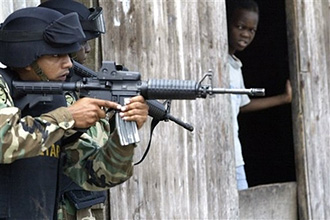 |
 |
 |
 News Around the Republic of Mexico | June 2007 News Around the Republic of Mexico | June 2007  
Mexicans End Colombian Monopoly In Cocaine Smuggling: UN
 News Post India News Post India
go to original


| | Colombian soldiers patrol through Buenaventura, Colombia, Monday, June 25, 2007. A wave of bombings has affected the city, home to Colombia's largest port; authorities are blaming leftist rebels from the revolutionary Armed Forces of Colombia, FARC. (AP/Inaldo Perez) |
Well-organised drug syndicates in Mexico have left behind their rivals from Colombia in cocaine peddling, says a UN report.

'Colombian groups have lost their monopoly over cocaine trafficking altogether, and currently most of the drugs reportedly enter the US in the hands of Mexican organised crime groups,' says the annual report on global drug trafficking and abuse issued by the UN Office on Drugs and Crime (UNODC).

According to UNODC, over the past two decades, the Mexican groups, which had previously been used instrumentally by the Colombians, have increasingly taken control of the US market.

'This transfer of responsibilities has not been complete, however, and Colombian groups as well as their Dominican associates remain prominent in the wholesale and retail trades in the northeast part of the US. Presently, Mexico is the premier gateway for cocaine entering the US,' the report says.

According to the US government, roughly 90 percent of the cocaine entering the country transits through Mexico and three quarters of the cocaine seized entering the US is apprehended along the land border with Mexico, particularly the border with Texas.

'At least 1,400 drug-related murders occurred in Mexico in 2006, mostly along the border with the US, with some sources placing the number as high as 2,500,' the report notes.

It says that like the Colombian organisations, Mexican criminal syndicates often have a dynastic character, involving multiple family members at the top of the command structure.

The report also shows that due to the highly competitive and violent nature of Mexican criminal syndicates, it is extremely difficult for foreigners to operate in this market. Ninety-eight percent of those arrested for drug trafficking in 2004 were Mexican nationals.

However, the report says most of the world's cocaine still moves from or through Colombia and the major chunk is consumed in the US.

In a coca cultivation survey carried out in 2005, the UNODC and the government of Colombia found that only one third of the farmers were just cultivators - the rest were involved in processing the plant into drugs, up to the point of creating cocaine base.

'The global cocaine production was 1,008 metric tonnes (mt) in 2004, of which 640 mt was produced in Colombia, 270 mt in Peru and 98 mt in Bolivia,' the report says. 'This indicates high levels of control over the cocaine supply. As is the case in many agriculture-exporting countries, export stock is not widely consumed locally.'

Mexican groups have also extended their reach and have expanded presence in producer countries, particularly in Peru. | 
 | |
 |



